If you want to be a good downhill skier, there are certain items you need to invest in. Skis, yes. Lessons, preferably. A warm hat. (Some people ski naked, but they always wear a hat.)
Well, if you want to be healthy (and a stronger skier), there are six items you need to invest in:
- A source of spring water and/or a whole house water purification system
- An organic garden or a share in an organic CSA farm
- Raw milk and cream (from your own milk cow, or a cow share from a raw milk dairy, or purchased directly if your state allows it)
- Local grass-fed meat and organic pastured poultry products
- A holistic practitioner trained in Standard Process nutritional therapeutics
- A Royal Lee Household Flour Mill
Let’s talk about the last item on the list. If you want to be healthy, you’ll need a flour mill. In spite of all the angry guts out there that won’t digest one thing or another (and with good reason, given the crap food they’re stuffed with); in spite of the bad rap wheat and grains still get (even though gluten sensitivity is related to the sugary, bleached, white flour products you’re eating—not the organic, heirloom, whole grain sourdough wheat you’re not eating); in spite of all the low-carb voodoo pins you’ve been sticking into those cinnamon buns (even though not all carbs are created equal). I’m here to tell you to get a flour mill so you can start eating fresh, whole ancient grains and bread. Preferably with raw butter. If you want to be healthy, that is.
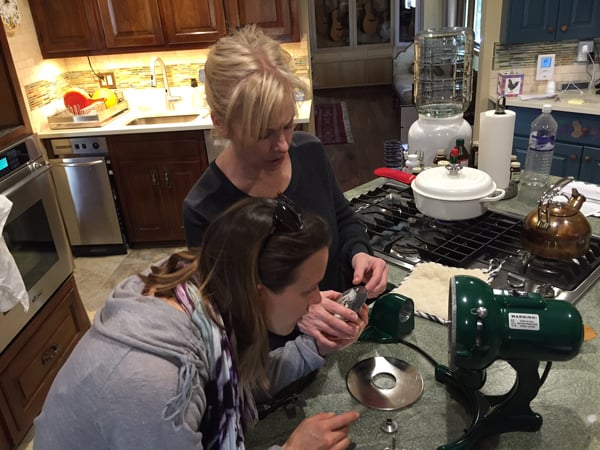
Of course you shouldn’t eat sugar-infused white flour cinnamon buns! But not because they’re high in carbs. You shouldn’t eat them because they’re full of refined, foodless ingredients—the very culprits responsible for the digestive distress you now chronically own. You should eat cinnamon buns and all manner of baked goods, but only if they’re made with freshly milled organic whole grains. And raw honey. Yes, they’re still high in carbs. But these carbs burn slowly and offer your body plenty of good nutrients and fiber. And you only eat them once in a while anyway…so pass the butter, please.
Before you read on, if you suffer from a weak, unbalanced, disgruntled digestive system, file this post until after your holistic practitioner has restored you to the world of digestive harmony.
If your digestive system is doing just fine, and you can eat whole grain bread and grains, then listen up. The folks at OrganicsbyLee.com have released a modernized version of Dr. Royal Lee’s original home flour mill.
The First Household Flour Mill: Built to Last
You might be wondering, What’s the big deal? Household flour mills are easy to find. Here’s the big deal: Dr. Lee invented the flour mill for home use in 1927. His was the first household mill ever. Handmade, of course. He machined all the parts to fit together with precision. Once the castings were poured at Dr. Lee’s aluminum foundry and the motors were wound at Lee Engineering, the mill took several days to assemble, with a cost of over $1,500 to produce each one. Over the decades, the mill has proven to be extremely reliable, and many from the last fifty years are still operational.
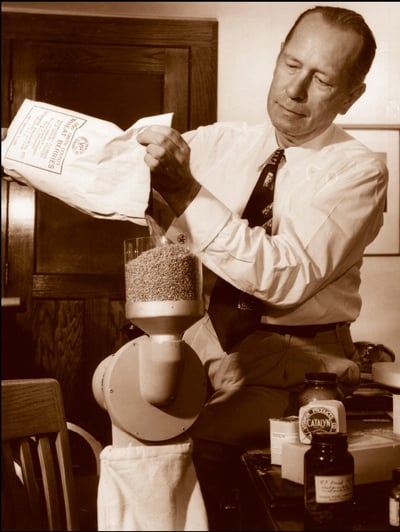
The truth is, Dr. Lee dedicated his life to restoring our relationship with food, nutrition, and health. That makes the fact that he designed the first household flour mill rather significant. As he worked on his invention, he applied his vast network of knowledge to make sure the precious perishable oils and nutrients in grains would be preserved rather than destroyed in the end product. Knowing that wheat flour is almost as perishable as milk, Dr. Lee designed his home flour mill so that anyone could get the freshest nutrients possible from grain, rather than be stuck with stale, store-bought flour. The Lee Mill is yet another ingenious tool that helps us manage our own health with our own hands.
A note on storage: If left in a container in your pantry, freshly milled flour will go bad in about two days. Some say it should last for five days, but we think this is pushing it. If stored in the refrigerator in a sealed container, freshly milled flour should be good for ten days. Stored in a container in the freezer, freshly milled flour will be good for thirty days. But keep in mind that some nutrients are destroyed by freezer temperatures. For the healthiest whole grain flour, you want it freshly milled.
Dr. Lee recognized that whole grain bread is still the staff of life—a staple of the global diet. And this phrase originated in the 1600s so we know it wasn’t just some 17th century Age of Reason marketing ploy. The observation was made long ago by people who saw the goodness in grain and the strength of the people who ate it. They too were built to last.
“Dr. Lee’s systems thinking approach to biologic networks asserted that a vitamin is not a single compound, but a group of interdependent compounds. He also stated that these compounds form a ‘nutrient complex’ so intricate that only a living cell can create it. The Lee Foundation for Nutritional Research published several writings focusing on the beneficial nutrient complexes in butter, brown rice, oats, barley, rye, barley, corn, bread potatoes, sauerkraut and flour.”
—Excerpt from “Origins of the Lee Household Mill—The 20s”
Enter Lee Engineering
But not just any old bread deserves to be called the staff of life. The bread must be made from real grains and freshly milled. Not from GMO crops. Not refined, bleached, brominated, fortified with synthetics, pesticide-exposed imposters. It must be real grain. Yes, soaked, fermented, and sourdoughed to make them easier to digest. But REAL—heritage, heirloom, landrace grains. Full of irreplaceable nutrients. This is the staff of life that Dr. Lee sought to make available to us. And stone ground is the best way to do that.
To this end, the president of Standard Process, Charles DuBois, set the General Manager of Lee Engineering, Steven Nichols, on a mission. His task was to modernize the original Lee Mill. Earlier this year, Mr. Dubois proudly announced:
“The Lee Engineering team, a division of Standard Process, has been working really hard this past year redesigning the Lee Household Flour Mill. They have kept intact all the great features from Lee’s original design, but have also made dramatic improvements in clean ability, reliability, and affordability.”
Indeed, Mr. Nichols followed Lee’s original design to ensure the heat generated by the mill would not exceed temperatures known to cause a loss of essential fatty acids and amino acids (which can occur at milling temperatures of 170oF). The redesign of Lee’s 1949 “attrition-type flour mill” combines Dr. Lee’s centrifugal governor and stationary stone mill with a modern variable torque motor.
“A further object is to provide a grinding mill having a stationary abrasive member or stone against which the grain or other granular material to be ground is spun or whirled at high-speed by centrifugal action to effect rapid attrition of the material with a light touch.”
—Dr. Royal Lee, 1927
Unlike the original mill, which was intended only for wheat and corn (back then GMO grain didn’t exist, and wheat and corn were still healthy foods), the updated model has been modified to easily grind smaller grains, such as amaranth and quinoa, in addition to a wide range of larger grains.
Mr. Nichols’ work to modernize Dr. Lee’s patented flour mill has also made it more affordable by reducing the amount of labor needed to assemble it. To do that, Lee Engineering partnered with Midwestern machinists and foundries to take full advantage of the precision offered by today’s Computer Numerical Control (CNC) equipment. (Imagine what Dr. Lee could come up with if he had had a modern CNC machine!)
So now being able to grind your own flour right before baking is a luxury you can afford. Or think of it this way: if you can afford medical bills later, you can afford a home flour mill today.
In addition to the health benefits, you’ll also experience the joy of making flour at home that’s as fine as any commercially milled flour. This is a difference you can taste. The Lee Mill design results in a nutrient dense product, and nutrients = flavor. Plus, good luck finding truly stone ground breads in the grocery store.
Steel vs. Stone
Home grain mills use one of two grinding methods: steel cutting blades or stone grinders. Commercial mills use either millstones (though this is rare today) or metal rollers (which are destructive to the nutrients in flour).
Besides the Lee Flour Mill, the only other mill I’ve used that produces a truly fine bread flour is the WonderMill, but ultimately I wasn’t happy with it because it’s not a stone mill. Like many steel mills, it uses two sets of rotating steel blades, or teeth, that explode the grain. The flour is also warmer than what comes out of the Lee Mill. The interlocking blades in a steel mill spin within one another, Mr. Nichols explains, while grain is dropped in and hammered into flour. It’s an inexpensive design, but limited in its ability to produce a wide range of textures even though they claim it does. And the crushing effect on the grain causes the flour to be warmer than stone mills.
Another advantage of the Lee Mill is that it uses only one stone instead of two. This means no stones rubbing against each other. There are two concerns that arise from the double-stone method:
1. Corundum dust in your flour
Even if there is only one stone, some people worry that corundum stone, being a composite made with aluminum bound to oxygen (aluminum oxide), can leave aluminum in the flour. Yet when Mr. Nichols had a central lab perform a spectrometric analysis on the flour, the results certified that the Lee Mill contributed no aluminum. And it never has, as you can see from the following letter Dr. Lee wrote in 1957 (it was a common practice of Dr. Lee’s to correspond and interact directly with his customers):
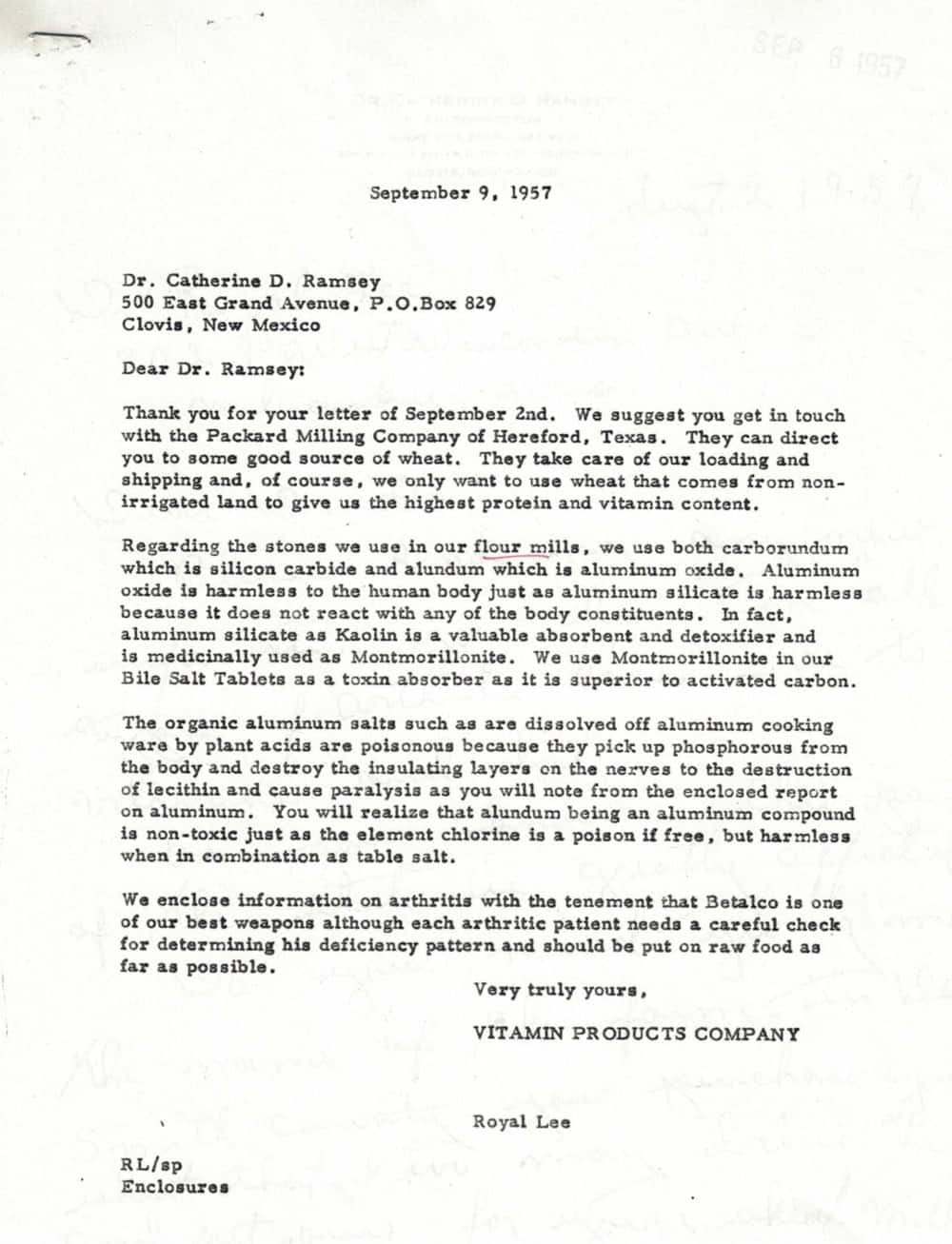
2. Inability to produce a pastry fine flour
Although this might be more information than you need, here is a good demonstration of how the 2-stone mill works.
Mr. Nichols points out that the action of the stone grooves (furrows) that flow the grain across the stone is what ultimately dictates flour fineness. “We have a smaller Schnitzer in our shop. It contains furrows, but only 3 to 4 in each stone. I am speculating but this could be why the mill has some fineness limitations.”
Comparison of Three Mills
Full disclosure: I’ve had an original Lee Flour Mill for four decades, a Schnitzer stone mill for about twenty years, and a WonderMill for about two years. I recommend that you do more research online to compare mills because I’m all in for the Lee Mill!
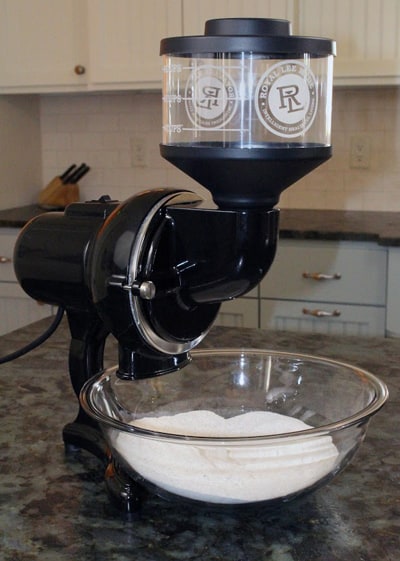
Lee Household Flour Mill: Built entirely in the United States, this is a handsome, powerful machine of heavy cast metal with one corundum stone. You have four sharp, stately colors to choose from: green, black, white, and red. Like an F150 Raptor truck just back from an off-road adventure, this mill stands there looking all badass and ready for action…especially when it’s covered in flour dust.
One of the impressive changes to the original mill is how much texture variety the various settings produce. Although it doesn’t produce cracked cereal grain, it does produce truly coarse flour all the way to the finest pastry flour. With the coarser textures you can produce flour crumb toppings, beautiful Graham flour, or flour for dredging poultry, fish, or meat. On the medium and medium-fine settings you can produce bread flour, and on the fine settings you’ll make the finest cake flour.
Some might consider it a negative that the Lee Mill doesn’t grind coarse enough to make cereal. However, it’s a dedicated flour mill, and Mr. Nichols reports not wanting to make such a drastic change to the original design. If you also want to grind cereal, a hand-powered grinder works great. No need to buy an expensive electric-powered flour mill for this purpose, unless you need a large amount of cereal.
What the Lee Mill does do—and I think it does better than anything else on the market—is efficiently reduce the entire grain kernel into perfect, fine baker’s flour that doesn’t need sifting in one pass, while still preserving all the whole grain oils and nutrition.
Perhaps that dedicated excellence is why Steve Nichols had such an enlightening experience working on the Lee mill redesign:
“It’s been fun and interesting working on the mill because I came into this from my work in the field of medical devices. So I brought the background of manufacturing UL rated devices. The best part about working on this project has been my exposure to the nutritional benefits of this product, and all Dr. Lee’s products, and organic farming. Coming from more of a business and conventional world into the world of how life should be, I realized that society lives in an alternate reality. This opened my eyes to the real world.”
Cleaning: Easily comes apart for cleaning, which mostly involves simply brushing or wiping off flour dust. Getting rancid flour out of the mill is important for obvious reasons. You can find short videos that demo the process at the website. One potential downside to cleaning this mill is that if the grain has too high a moisture content, the flour will gum up when you grind it, so you’ll need more time for cleaning. But Mr. Nichols and his team have identified the few grains that need drying in your oven or dehydrator before milling so you don’t have that problem. This information is included in the Farro and Kamut sections of the Flourpedia.
For videos and info about using the mill, check the “Milling” page.
The Lee Mill sells for $799.
WonderMill: Built in South Korea from BPA-free plastic and metal, the WonderMill comes in as the cheapest of the three. I’m not thrilled with how much warmer the flour feels than it does after grinding in the Lee Mill. Maybe this is because of the metal grinder and/or the exploding of grain (rather than natural friction). It comes with lots of attachments, and it definitely does the job. But by its very design the WonderMill can’t preserve the nutrients as effectively as a stone mill. Still, if you can’t afford a stone mill, this is a good option.
Cleaning: Easily comes apart, but there are so many parts! And being plastic, they need washing, or at least rinsing. I found that cumbersome.
The WonderMill sells for $220-320.
Schnitzer Stone Mill: Made in Germany, this mill is housed in beautiful beachwood and uses two corundum stones. The company makes a wide range of electric and hand mills. Although I owned an original Lee Mill for many years, it was too limited in the range of grain it could grind. So until the new Lee Mill took up residence in my kitchen, the Schnitzer was my favorite when I needed to grind grain that the original Lee Mill couldn’t.
The Schnitzer mill is a stone mill, yes, but it isn’t capable of producing a professional level of fine pastry flour, though it does make great cereal and adequate flour. All in all, a great mill. However, my Schnitzer is over ten years old and cost about $600 back then. Perhaps the newer models do a better job.
The Schnitzer is not available in the U.S. except perhaps on Ebay. You’ll find them online at the Australian-based company Skippy Grain Mills. Skippy also provides good info on the corundum stone.
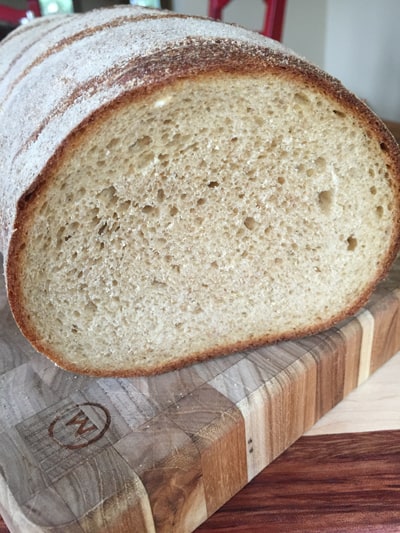
Cleaning: To clean this mill, you simply run some rice through it. But when I had a friend take mine apart (not something you should do unless you have special powers), I found plenty of old flour in there even though I’d cleaned it with rice after each use. That means some rancid flour is going to get into your food.
The Schnitzer Electric Stone Mills range from just under $800 to almost $1,000.
In case you can’t tell, the Lee Mill is my favorite! First, this is a company that I know would never mess with my food quality just to cut costs. Second, the Lee Mill’s strength is in the production of the most beautiful textures of flour I’ve ever seen in a home mill. Third, Standard Process has a nine-decade long reputation for excellence. Find out for yourself by contacting the folks at Organics by Lee. Their customer support is outstanding, and their clinically tested knowledge of holistic nutrition directs their product design. If that’s not enough, they even carry a small selection of organic grains. The buckwheat is growing right now on Standard Process organic farms (and will be available after the fall harvest), and any grain they source from other organic farms is tested for GMO and pesticides and submitted to other quality standards.
So what’s it gonna be? Ski lessons? Or a Lee Household Flour Mill?
Photo at top of Spelt and Khorasan sourdough by Stephanie Anderson


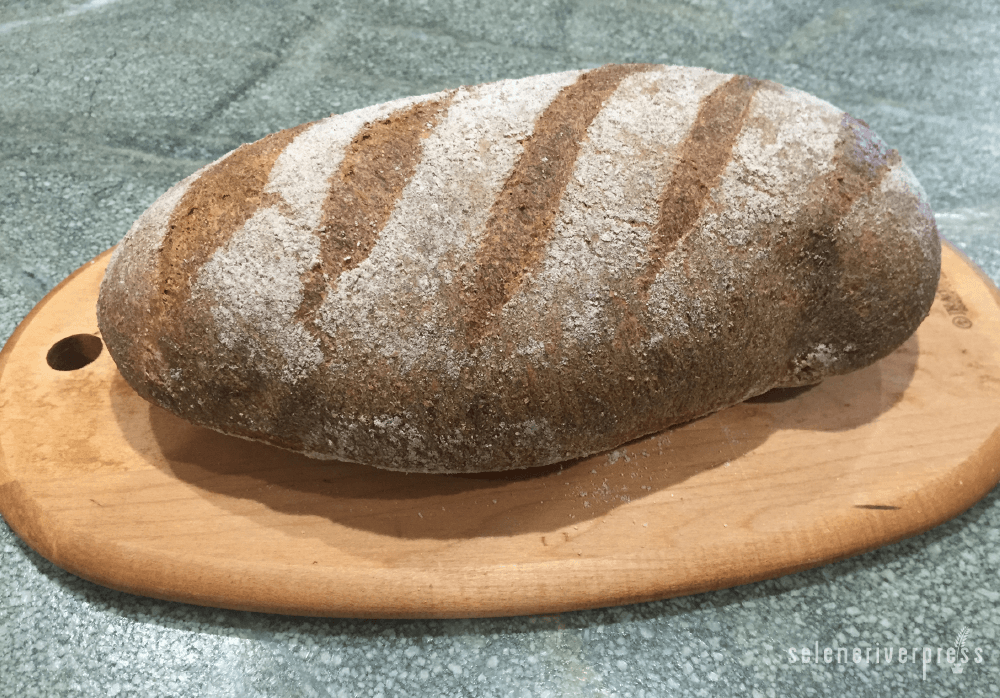

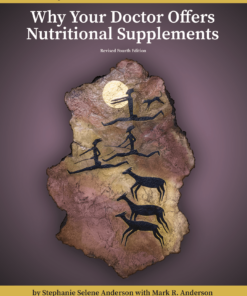
I’m a single fella and eat little bread now. How can I ferment an individual batch of dough without first having a starter, especially if I only make bread once a month or less?
I don’t know if that’s possible, Allen! For flour to ferment takes a few days. But give me some time and I’ll ask around. Meanwhile, you might be happy to know that if you have a sourdough starter in your fridge you can use it whenever you need it so long as you feed it now and then. See if this article helps you better understand how that works: http://www.splendidtable.org/recipes/sourdough-bread. And if I find any other methods, I’ll let you know.
What has been your experience with baking bread with fresh milled flour? I’ve read several articles that say you have to allow the flour to mature before making bread to strengthen the gluten structure through the development of disulphide bonds. The thiol in freshly milled flour is an adjacent compound and it blocks the development of disulfide bonds that help form the gluten. It is the presence of oxygen that neutralizes the thiols allowing the disulfide bonds to form and the resulting cross-linking of the gluten molecules helps form a gluten matrix. As the oxygen gently gets in to the flour the protein structure hardens and strengthens and therefore matures, so after about 4 weeks of being left to mature the flour is then ready to bake bread with. The fresh milled, green flour, is good for cakes, muffins, pancakes, etc. where gluten development is not needed. I’ve been researching grain mills to mill my own flour for the nutrient value but am still studying this bread flour issue. I have enough challenges trying to get my sourdough to be something other than a brick that I am concerned with using fresh milled flour.
I haven’t heard that the flour has to “mature” before baking and I’ve baked for many years, learning from professionals. But there’s always someone who knows something I don’t! I can tell you that the freshly milled flour performs beautifully. Fermenting using a sourdough starter will ready it for highest digestibility in just a few hours. As to your bread being a brick, I’m not sure if you truly mean that it’s so unpleasantly dense that no one wants to eat it or if you’re not used to whole grain bread. It sounds like you need a good book on the topic or a class. Check out this book and see if it has some answers for you: https://www.amazon.com/Build-Your-Own-Earth-Oven/dp/096798467X/ref=sr_1_2?ie=UTF8&qid=1467763292&sr=8-2&keywords=simple+sourdough+bread
Hi Gay, it turns out that the link I mentioned is to a book that’s mostly about making a wood-fired oven. But the author has a simple sourdough recipe that you might like to see here: http://www.splendidtable.org/recipes/sourdough-bread
Thank you for the recipe Stephanie. I’ll give it a try. I’ve been baking yeast breads successfully all my life but am having trouble with the switch to sourdough. The loaves are dense but still edible and have good flavor. I’m just trying to get more loft in the bread. I’m finding that baking in cast iron helps. Also not to proof the dough as much as with a yeast bread so I can get more oven spring when I put it in.
I had read a really good article out of the U.K. about maturing flour. This is the link, http://www.sourdough.co.uk/oxidizing-and-over-oxidizing-flour/ unfortunately it looks like you need to be a member to access it now. That’s too bad, it was a very interesting article. The information in my original comment had been notes taken from this article.
These two links have some info. http://www.azeliaskitchen.net/oxidising-fresh-flour-over-oxidising-over-mixing-dough/
http://muehlenchemie.de/downloads-future-of-flour/FoF_Kap_18-3.pdf
Hi Gay. I took a look at the two articles but it seems to me that oxidizing flour is exactly what we’re trying to avoid because that’s what destroys nutrients. In fact, white bleached flour was oxidized using chlorine, maybe it still is. I might be missing something but any process that requires flour to lay about for days or weeks before baking is nutritionally useless. It’s astounding what has been done to bread over the ages to get it to behave in certain ways! I hope you’re finding better info on how to make a nutritious loaf you also enjoy eating.
Good stuff! Thank you for laying all of this out, Stephanie.
Do you have a recommended source for whole grains to use with the mill? BTW Awesome article!
Thanks, Joseph! You’ll find superb organic grains at Organics by Lee: https://www.organicsbylee.com/c/4/grains. Other sources I use are Bluebird Grain Farms: https://bluebirdgrainfarms.com/ and Fieldstone Organics: http://fieldstoneorganics.ca/products/index.php. You can find more references in the $3 Weston A. Price Shopping Guide: https://www.seleneriverpress.com/shop/weston-a-price-foundation-shopping-guide-for-finding-the-healthiest-food-brands-in-supermarkets-health-food-stores-and-by-mail-order/? Good luck!